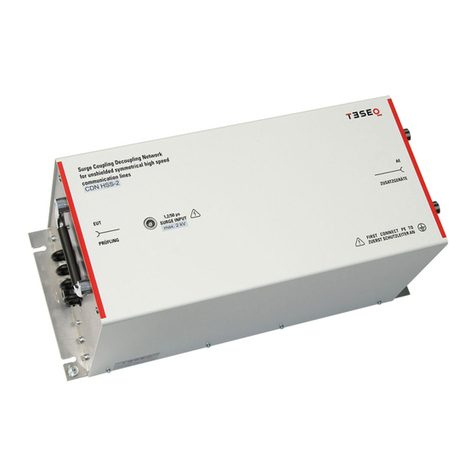AMETEK CTS CDN 118A series
Operating manual V 1.00 3 / 26
Content
1. General.............................................................................................................................4
1.1. Intended use.......................................................................................................................................4
1.2. Safety label on the device ..................................................................................................................4
2. Safety................................................................................................................................5
2.1. Safety aspects....................................................................................................................................5
2.2. Testing and danger.............................................................................................................................6
2.2.1. Coupling networks..............................................................................................................................6
2.2.2. Danger from EUT ...............................................................................................................................6
3. Standards for testing with coupling networks of CDN 118A series............................7
3.1. Device models....................................................................................................................................8
3.2. Impulse generators.............................................................................................................................8
4. Device functions and operating.....................................................................................9
4.1. Coupling network CDN 118A-C4-4-1 and CDN 118A-C6-4-1............................................................9
4.2. Device components CDN 118A-C4-4-1 and CDN 118A-C6-4-1........................................................9
4.3. Test Setup for I/O and datalines.......................................................................................................10
4.4. Test setup for 1.2 µs / 50 µs impulses .............................................................................................11
4.5. Test setup for 10µs / 700µs impulses...............................................................................................12
4.6. Diagram CDN 118A series...............................................................................................................13
5. Technical data ...............................................................................................................14
5.1. CDN 118A series..............................................................................................................................14
5.2. Weight and dimension......................................................................................................................15
6. Maintenance...................................................................................................................16
6.1. General.............................................................................................................................................16
6.2. Calibration and Verification...............................................................................................................16
6.2.1. Factory calibration ............................................................................................................................16
6.2.2. Guideline to determine the calibration period of AMETEK CTS instrumentation.............................16
6.2.3. Calibration of Accessories made by passive components only .......................................................16
6.2.4. Periodically In-house verification......................................................................................................16
6.3. Maintenance, Adjustments, Replacement of Parts ..........................................................................17
7. Calibration procedure as per IEC 61000-4-5 Ed3........................................................18
7.1. Calibration Surge impulse (1.2/50 μs –8/20 μs)..............................................................................18
7.1.1. General ............................................................................................................................................18
7.1.2. Calibration procedure for CDNs for symmetrical interconnection lines ..................................18
7.1.3. Surge waveform definition on CDN for symmetrical interconnection lines.............................19
7.2. Calibration Telecom Surge impulse (10/700 μs –5/320 μs)............................................................20
7.2.1. General ............................................................................................................................................20
7.2.2. Calibration procedure for CDNs for symmetrical interconnection lines..................................20
7.2.3. Telecom Surge waveform definition.............................................................................................21
8. Delivery Groups.............................................................................................................22
8.1. Delivery groups CDN 118A-Cx-4-1 ..................................................................................................22
8.2. Accessories ......................................................................................................................................22
9. Appendix........................................................................................................................23
9.1. Declaration of conformity..................................................................................................................23
9.2. Typical waves...................................................................................................................................25
9.2.1. Voltage waveform...........................................................................................................................25
9.2.2. Current waveform...........................................................................................................................25
9.2.3. Residual voltage waveform ...........................................................................................................26
9.3. Transferfunction................................................................................................................................26





























